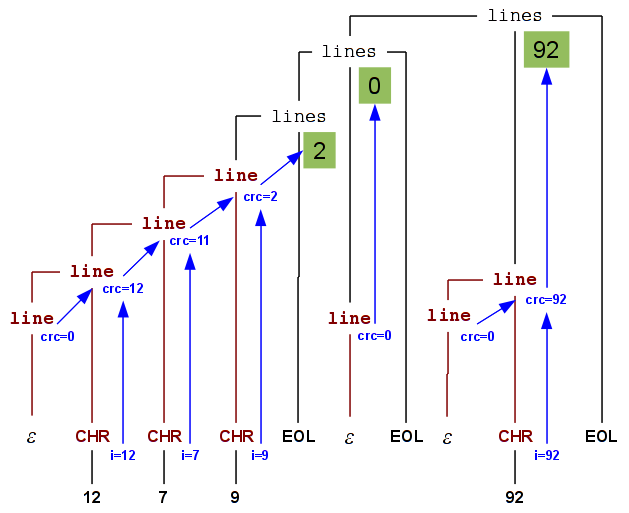Attribute Grammars/Exercise 7: Lines, characters, and CRCs
From Wiki**3
Problem (in Portuguese)
(appeared in Teste 2 2009/2010)
Considere uma linguagem constituída por uma sequência, não vazia, de linhas. Cada linha é constituída por uma sequência, possivelmente vazia, de caracteres. Pretende-se determinar o número de controlo de erro (CRC) de cada linha de texto. Para tal, o analisador lexical produz dois tipos de lexemas: CHR (número inteiro que representa o código do carácter lido); EOL (fim de linha). Escreva um programa que imprima, após o fim de cada linha (EOL), o correspondente CRC (iniciado a 0 em cada linha, é calculado através de um “ou exclusivo” com o valor inteiro do carácter lido).
- Identifique uma gramática que reconheça a linguagem descrita.
- Determine os atributos de cada símbolo e indique, justificadamente, o tipo de gramática obtida.
- Represente a árvore decorada para a frase seguinte, indicando a sequência de valores impressos no seu processamento.
CHR.i=12 CHR.i=7 CHR.i=9 EOL EOL CHR.i=92 EOL - Escreva uma especificação YACC que realize a solução do problema acima. A gramática não deve ter conflitos.
Solution
The problem has a simple solution, with just two non-terminal symbols: one to account for multiple lines (lines), and another to account for multiple characters in a line (line) (a line can be empty, i.e., it may not have any characters).
lines → line EOL { printf("%d\n", line.crc); }
lines → lines line EOL { printf("%d\n", line.crc); }
line → ε { line.crc = 0; }
line0 → line1 CHR { line0.crc = line1.crc CHR.i; }
All attributes are synthesized (S-attributed grammar): crc encodes a line's CRC.
The following is the annotated tree for CHR.i=12 CHR.i=7 CHR.i=9 EOL EOL CHR.i=92 EOL. The green boxes represent print operations (of the displayed value).
A YACC specification can be obtained by adapting the grammar above: <text>
%union { int i; }
%token CHR
%token EOL
%type line
%%
lines : line EOL { printf("%d\n", $1); }
lines : lines line EOL { printf("%d\n", $2); }
line : /* empty */ { $$ = 0; }
line : line CHR { $$ = $1 ^ $2; }
%%
</text>
